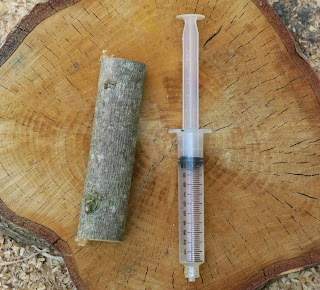
I thought it would be good see how much it would shrink by sticking it the microwave to dry it out. Even though I used branch wood the hole went a bit oval and I had to refit the lid. It is very easy to make stuff from green wood and wait a while and assume it is dry. So this could have been very embarrassing if I sold it, and a month later I got a call saying it had split or the lid was stuck. This is why I like to leave my wares at least a few months or even half a year or more before selling. Wood takes a long time to settle down and stop moving and drying.
This is the small elm branch blank next to a 10ml syringe. The wood weight was 58grams before drying and 48 after, that is 10 grams of water or 10ml in total. Very far from dry. Okay this wood is oven dry, which is as dry as it can get, it will absorb moisture from the atmosphere and reach an equilibrium.
I thought about green wood, so here is a small branch of sycamore. From green to dry 109 gm to 56 gm dry that is almost half the woods weight 53 gm of water or 53ml. 1gm of water or 1ml of water is 1cubic cm. I will keep this bit of wood and weigh it every month or so to track how much water it gains again.
Below is an article I wrote for Living Woods magazine which explains how to measure the moisture content of any plank or branch wood.
Moisture in wood. Sean Hellman
Moisture meters are not the only way to measure moisture content of wood, there is a cheaper way, and you may have all the tools needed already, in your kitchen. I am talking about the traditional standard for measuring the moisture content of wood which is the oven drying method.
A small sample piece of wood is cut from the plank or log that you want to determine the moisture content of. This sample is weighed and is represented as, Ws. The sample is then put into an oven at no more than 103 centigrade. This sample is then weighed every so often until a constant weight is achieved. This figure is represented as Wod.
Moisture content is expressed as a percentage, and is calculated with the formula:
Ws - Wod
MC = ___________ X 100
Wod
The Ws weights of my samples are Cherry 163g, Oak 188g, Ash 131g and some kiln dried oak that had been sitting in my workshop for some months 121g.
The oak sample was from green oak from some chainsaw sculptures I had made and it was still very green. The readings are: 188g Ws , and after drying 122g Wod.
Ws, 188g minus Wod 122g = 66 divided by Wod 122g = 0.54098 multiplied by 100 = 54.1% moisture content, which is wet.
In using this method I soon realized that the wood sample should not be too small and light. Also, the weighing scales should be able to read 10ths of a gram to get more accurate results. In this above example a 1 gram difference in weight, 123g instead of 122g, then the sample would have a moisture content of 52.8%. This is not a big deal in wet samples but if you have a small sample which is already quite dry, as in the kiln dried oak sample, a 1g difference will make a 1% change in the moisture content.
Once you have weighed and dried your samples of wood leave them in your workshop and weigh them every couple of weeks or so. By doing this you will gain an understanding of just how hydroscopic wood is and which woods absorb moisture faster than others.
Readings taken a week after oven drying
Cherry 128g, oak137g, ash 109g, kiln dried oak 114g
For example, the oak sample, which is an end grain slice, and over a week has reabsorbed moisture from the atmosphere fastest out of all the samples and now has a moisture content of 12%.
It is tempting to take a sample slice from the end grain of your board. Do not do this, as you will not get accurate moisture content of the board, end grain will dry out faster than wood in the centre of a board. If measuring the moisture content of a board 4 inches thick, cut a slice off at least 2 feet into the board, cut out the centre 2 inches, and measure these two samples separately. Wood will dry out on the outside faster than the inside and by using this technique you may find that the outside of the board is a lot drier than the inside. If a plank is dried rapidly or improperly you can get case-hardening, which means the outside is drier than the inside. This can lead to false moisture meter readings as most cheaper meters can only read up to a maximum of a centimetre below the surface of the wood. Case-hardened wood will warp in use and can be difficult to cut.
Even if you do own a moisture metre, this oven drying process can still be useful, as you can check that the meter is working and is calibrated correctly.














No comments:
Post a Comment
Sorry, because of the huge amount of dubious people leaving spam comments for their useless stuff, I unfortunately have to bring back word verification.